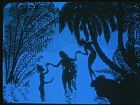- The Adventures of Prince Achmed
-
Die Abenteuer des Prinzen Achmed 
Title cardDirected by Lotte Reiniger Written by Lotte Reiniger Cinematography Carl Koch Distributed by Comenius-Film GmbH Release date(s) July 1926 (France) Running time 65 minutes
(at 24 frames/s)Country Weimar Republic Language German The Adventures of Prince Achmed (German: Die Abenteuer des Prinzen Achmed) is a 1926 German animated fairytale film by Lotte Reiniger. It is the oldest surviving animated feature film; two earlier ones were made in Argentina by Quirino Cristiani, but they are considered lost.[1] The Adventures of Prince Achmed features a silhouette animation technique Reiniger had invented which involved manipulated cutouts made from cardboard and thin sheets of lead under a camera. The technique she used for the camera is similar to Wayang shadow puppets, though hers were animated frame by frame, not manipulated in live action. The original prints featured color tinting.
Several famous avant-garde animators worked on this film with Lotte Reiniger. These included Walter Ruttmann, Berthold Bartosch, and Carl Koch.[2]
Contents
Plot
The story is based on elements taken from the collection 1001 Arabian Nights, specifically The Story of Prince Ahmed and the Fairy Paribanou featured in Andrew Lang's The Blue Fairy Book. With the assistance of Aladdin, the Witch of the Fiery Mountain, and a magic horse, the title character reclaims the magic lamp and conquers the African sorcerer. The culminating scene in the film is the battle between "die Hexe" (the witch) and "der afrikanische Zauberer" (the African sorcerer), in which those characters undergo fabulous transformations. All is well in the end: Aladdin marries Dinarsade (Achmed's sister and daughter of the Caliph); Achmed forces Pari Banu to marry him; the African sorcerer is defeated; and the foursome return to the Caliph's kingdom. Later Pari Banu- a goddess- steals a featherboa from Achmed so she can turn into a bird and fly home.
Restoration
No original German nitrate prints of the film are known to still exist. While the original film featured color tinting, prints available just prior to the restoration had all been in black and white. Working from surviving nitrate prints, German and British archivists have restored[3] the film in 1998/99 including reinstating the original tinted image by using the Desmet method.
Availability
The film is screened fairly often on Turner Classic Movies. English-market DVDs are available, NTSC R1 (from Image) and PAL R2 (from the BFI). Both versions of the DVD are identical. They feature both an English-subtitled version (the intertitles are in German) and an English voice-over.
Score
The original score was composed by German composer Wolfgang Zeller in direct collaboration with the animation of the film. Reiniger created photograms for the orchestras, which were common in better theatres of the time, to follow along the filmic action.[4]
The Silk Road Ensemble accompanied the film with a live improvised performance on Western strings and instruments such as the oud, ney and sheng in October 2006 at the Rubin Museum of Art in New York, NY.[5] The Silk Road Ensemble repeated the performance at the Avon Cinema in Providence, RI, in February 2007.[6]
The British film composer Geoff Smith composed a new score for the film in 2008, which he performed live as an accompaniment to screenings of the film.
An alternative score was written and presented to the public December 16, 2009 by Indian composer and guitarist, Rahul Roy( the composer, not to be confused with an actor of the same name ). The authorized screening was presented at Forbes Library in Northampton, Massachusetts on that date, with over fifty people in attendance.
Another alternative score was conceived and performed by the British-Asian clarinettist and composer, Arun Ghosh and featured Adriano Adewale, Shabaka Hutchings, Jenny Adejayan, Corey Mwamba and Liran Donin to a packed house at the Albany in Deptford, the main space being transformed into a Bedouin lounge, as part of the Future Fusions Takeover festival on 18th March 2010. Arun Ghosh's score was presented as a live-action silhouette film with the musicians seen by the audience as shadows behind a screen in homage to Lotte Reiniger's cinematic style.[7]
Seattle composers David Miles Keenan and Nova Karina Devonie, aka "Miles and Karina", were commissioned by the Northwest Film Forum in 2007 to compose a new score to be performed live for its annual Children's Film Festival '08 and again in '09. The duo continue to perform their score with the film and have done so at Australia's Woodford Folk Festival '09/'10; The Tucson Fox Theater Nov. 2010; Denver Film Society's Starz Cinema Mar. 2010; Waterloo Festival for Animated Cinema Nov. 2008; St. Louis Art Museum Sept. 2008; Seattle International Film Festival April 2011; Bainbridge Performing Arts April 2011 and others. Their score uses accordion, guitar, banjo, glockenspiel, viola, percussion, slide whistle and other contraptions.
References
- ^ The Untold Story of Argentina's Pioneer Animator
- ^ Reiniger, Lotte. Shadow Theatres, Shadow Films London: BT Batsford, 1970.
- ^ Restauration report (in German) by Deutsches Filmmuseum
- ^ "The Adventures of Prince Achmed, or What May Happen to Somebody Making a Full Length Cartoon in 1926" by Lotte Reiniger in The Silent Picture volume 8, 1970, pp. 2-4.
- ^ Smooth operation — New York Magazine, October 1, 2006
- ^ A magical pairing of animated movie and live music — Providence Journal, January 28, 2007
- ^ [1]
External links
Categories:- German-language films
- 1926 films
- Animated feature films
- Children's fantasy films
- Films based on fairy tales
- Films of Weimar Germany
- German animated films
- German fantasy films
- Silent films
- Stop-motion animated films
- Works based on One Thousand and One Nights
Wikimedia Foundation. 2010.

